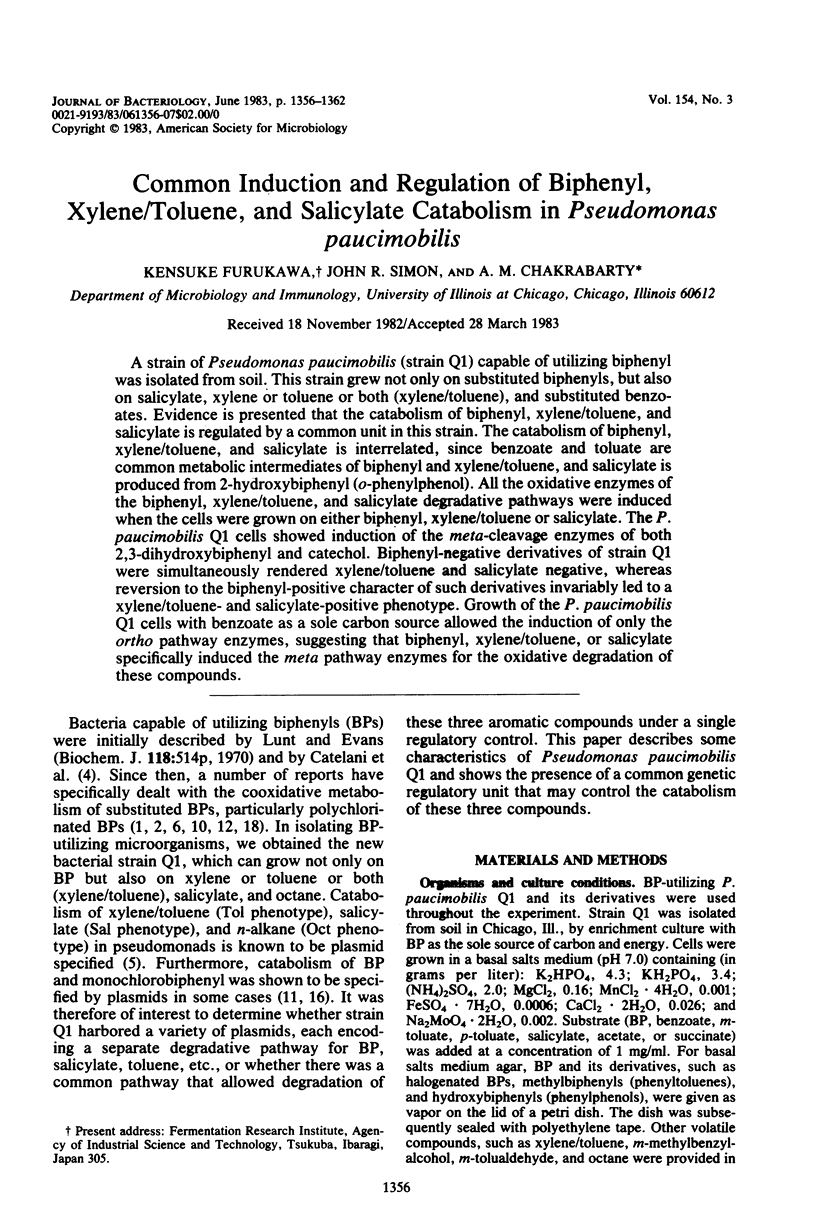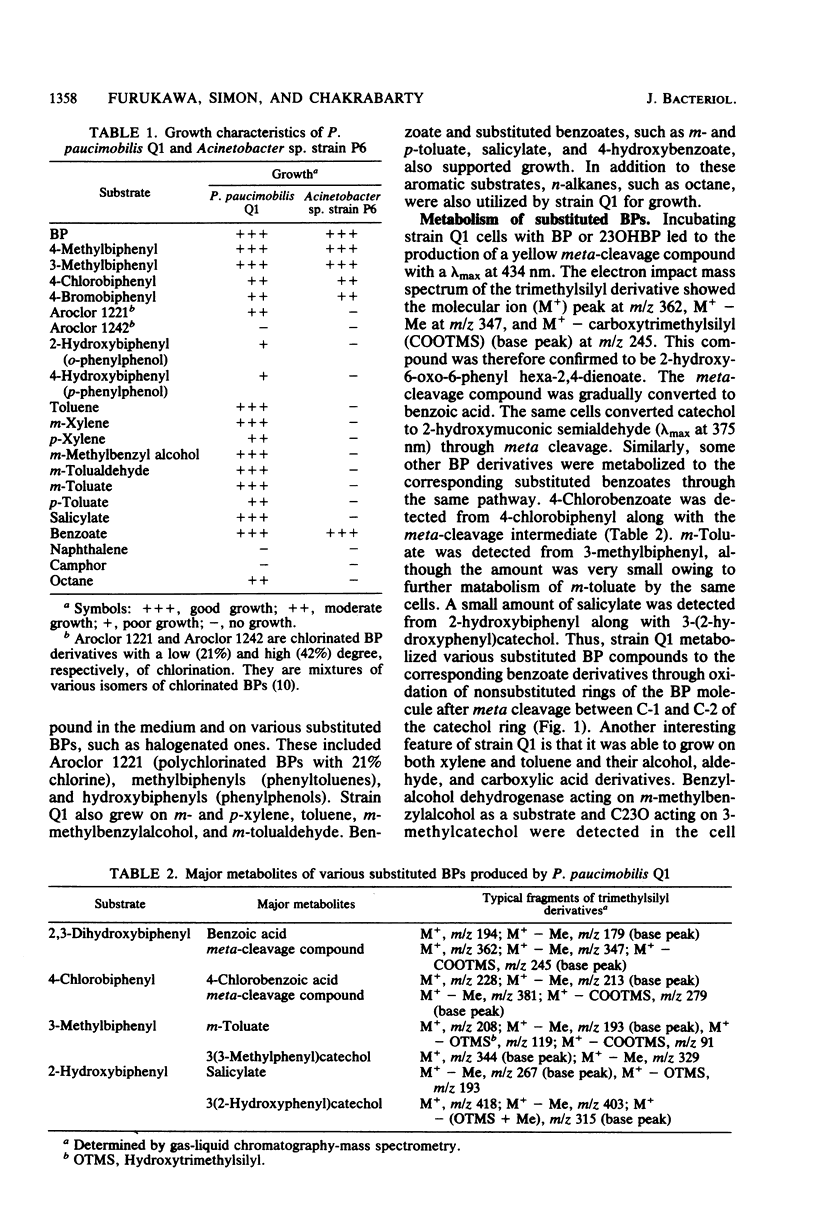Abstract
A strain of Pseudomonas paucimobilis (strain Q1) capable of utilizing biphenyl was isolated from soil. This strain grew not only on substituted biphenyls, but also on salicylate, xylene or toluene or both (xylene/toluene), and substituted benzoates. Evidence is presented that the catabolism of biphenyl, xylene/toluene, and salicylate is regulated by a common unit in this strain. The catabolism of biphenyl, xylene/toluene, and salicylate is interrelated, since benzoate and toluate are common metabolic intermediates of biphenyl and xylene/toluene, and salicylate is produced from 2-hydroxybiphenyl (o-phenylphenol). All the oxidative enzymes of the biphenyl, xylene/toluene, and salicylate degradative pathways were induced when the cells were grown on either biphenyl, xylene/toluene or salicylate. The P. paucimobilis Q1 cells showed induction of the meta-cleavage enzymes of both 2,3-dihydroxybiphenyl and catechol. Biphenyl-negative derivatives of strain Q1 were simultaneously rendered xylene/toluene and salicylate negative, whereas reversion to the biphenyl-positive character of such derivatives invariably led to a xylene/toluene- and salicylate-positive phenotype. Growth of the P. paucimobilis Q1 cells with benzoate as a sole carbon source allowed the induction of only the ortho pathway enzymes, suggesting that biphenyl, xylene/toluene, or salicylate specifically induced the meta pathway enzymes for the oxidative degradation of these compounds.
Full text
PDF






Selected References
These references are in PubMed. This may not be the complete list of references from this article.
- Ahmed M., Focht D. D. Degradation of polychlorinated biphenyls by two species of Achromobacter. Can J Microbiol. 1973 Jan;19(1):47–52. doi: 10.1139/m73-007. [DOI] [PubMed] [Google Scholar]
- Bayly R. C., Dagley S., Gibson D. T. The metabolism of cresols by species of Pseudomonas. Biochem J. 1966 Nov;101(2):293–301. doi: 10.1042/bj1010293. [DOI] [PMC free article] [PubMed] [Google Scholar]
- Chakrabarty A. M. Plasmids in Pseudomonas. Annu Rev Genet. 1976;10:7–30. doi: 10.1146/annurev.ge.10.120176.000255. [DOI] [PubMed] [Google Scholar]
- Clark R. R., Chian E. S., Griffin R. A. Degradation of polychlorinated biphenyls by mixed microbial cultures. Appl Environ Microbiol. 1979 Apr;37(4):680–685. doi: 10.1128/aem.37.4.680-685.1979. [DOI] [PMC free article] [PubMed] [Google Scholar]
- Davies J. I., Evans W. C. Oxidative metabolism of naphthalene by soil pseudomonads. The ring-fission mechanism. Biochem J. 1964 May;91(2):251–261. doi: 10.1042/bj0910251. [DOI] [PMC free article] [PubMed] [Google Scholar]
- Feist C. F., Hegeman G. D. Phenol and benzoate metabolism by Pseudomonas putida: regulation of tangential pathways. J Bacteriol. 1969 Nov;100(2):869–877. doi: 10.1128/jb.100.2.869-877.1969. [DOI] [PMC free article] [PubMed] [Google Scholar]
- Friello D. A., Mylroie J. R., Gibson D. T., Rogers J. E., Chakrabarty A. M. XYL, a nonconjugative xylene-degradative plasmid in Pseudomonas Pxy. J Bacteriol. 1976 Sep;127(3):1217–1224. doi: 10.1128/jb.127.3.1217-1224.1976. [DOI] [PMC free article] [PubMed] [Google Scholar]
- Furukawa K., Chakrabarty A. M. Involvement of plasmids in total degradation of chlorinated biphenyls. Appl Environ Microbiol. 1982 Sep;44(3):619–626. doi: 10.1128/aem.44.3.619-626.1982. [DOI] [PMC free article] [PubMed] [Google Scholar]
- Furukawa K., Matsumura F. Microbial metabolism of polychlorinated biphenyls. Studies on the relative degradability of polychlorinated biphenyl components by Alkaligenes sp. J Agric Food Chem. 1976 Mar-Apr;24(2):251–256. doi: 10.1021/jf60204a002. [DOI] [PubMed] [Google Scholar]
- Furukawa K., Tomizuka N., Kamibayashi A. Effect of chlorine substitution on the bacterial metabolism of various polychlorinated biphenyls. Appl Environ Microbiol. 1979 Aug;38(2):301–310. doi: 10.1128/aem.38.2.301-310.1979. [DOI] [PMC free article] [PubMed] [Google Scholar]
- Hegeman G. D. Synthesis of the enzymes of the mandelate pathway by Pseudomonas putida. I. Synthesis of enzymes by the wild type. J Bacteriol. 1966 Mar;91(3):1140–1154. doi: 10.1128/jb.91.3.1140-1154.1966. [DOI] [PMC free article] [PubMed] [Google Scholar]
- Inouye S., Nakazawa A., Nakazawa T. Molecular cloning of gene xylS of the TOL plasmid: evidence for positive regulation of the xylDEGF operon by xylS. J Bacteriol. 1981 Nov;148(2):413–418. doi: 10.1128/jb.148.2.413-418.1981. [DOI] [PMC free article] [PubMed] [Google Scholar]
- Tucker E. S., Saeger V. W., Hicks O. Activated sludge primary biodegradation of polychlorinated biphenyls. Bull Environ Contam Toxicol. 1975 Dec;14(6):705–713. doi: 10.1007/BF01685246. [DOI] [PubMed] [Google Scholar]
- Worsey M. J., Franklin F. C., Williams P. A. Regulation of the degradative pathway enzymes coded for by the TOL plasmid (pWWO) from Pseudomonas putida mt-2. J Bacteriol. 1978 Jun;134(3):757–764. doi: 10.1128/jb.134.3.757-764.1978. [DOI] [PMC free article] [PubMed] [Google Scholar]
- Worsey M. J., Williams P. A. Metabolism of toluene and xylenes by Pseudomonas (putida (arvilla) mt-2: evidence for a new function of the TOL plasmid. J Bacteriol. 1975 Oct;124(1):7–13. doi: 10.1128/jb.124.1.7-13.1975. [DOI] [PMC free article] [PubMed] [Google Scholar]


